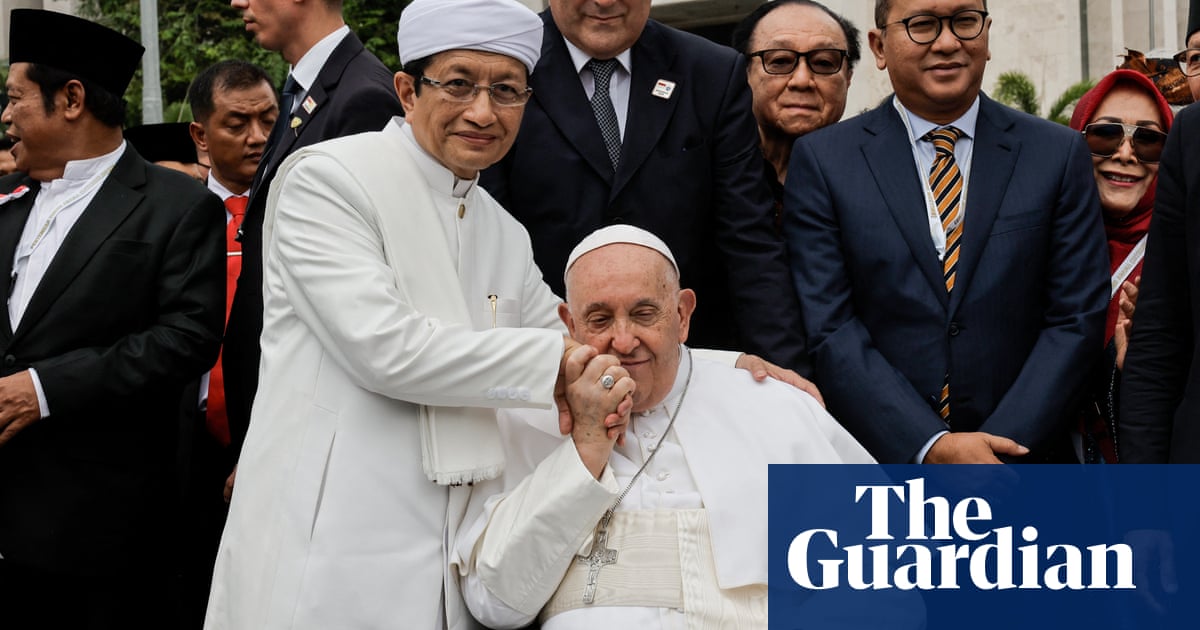When Pope Francis stepped on to the hallowed grounds of the Istiqlal mosque in the Indonesian capital on Thursday, he marked a historic moment in his quest to bridge the divides between the world’s major religions.
Dressed in a simple white cassock, he was greeted by Istiqlal’s grand imam, Nasaruddin Umar, and representatives from Indonesia’s six officially recognised religions – Islam, Catholicism, Protestantism, Buddhism, Hinduism, and Confucianism.
In a speech welcoming the pope, Nasaruddin underscored the need for peaceful coexistence amid global diversity.
“Our brothers and sisters worldwide continue to endure severe hardships due to conflict,” he said. “We also face an environmental crisis with climate change and global warming posing serious threats to our existence.”
For his part the pope highlighted the architectural contribution of Friedrich Silaban, a Christian who designed the mosque, the largest in southeast Asia, which opened in the 1970s.
“This testifies to the fact that throughout the history of this nation and in the very fabric of its culture, the mosque, like other places of worship, are spaces of dialogue, mutual respect and harmonious coexistence between religions and different spiritual sensibilities,” he said.
For many Catholics in Jakarta, Francis’ visit has been a source of pride and inspiration.
“The pope’s visit to Istiqlal shows a sense of togetherness in our diversity,” said Petrus Ohaira, a 48-year-old civil servant from Maluku in eastern Indonesia. He was one of about 100 people who had gathered outside the mosque to catch a glimpse of Francis.
“As the leader of the Catholic church, he embodies tolerance and humanity, always upholding respect for one another despite our differences in faith,” he said.
Silviana, a 45-year-old freelancer and an avid fan of the pope, said Muslims and Christians should respect each other. “My hope is that Indonesians will continue to practise religious tolerance and avoid creating divisions,” she said.
Suganda, a 58-year-old retiree, expressed hope that the Istiqlal visit would deepen the understanding of unity and tolerance in Indonesia. “It’s a great example for all of us. It proves there is no barrier between Muslims and Catholics,” he said. “Together, we can move forward.”
An ‘eloquent sign’ of friendship
Indonesia, a Muslim-majority country with over 270 million people, is renowned for its religious diversity and has long emphasised its constitutional principle of Bhinneka Tunggal Ika (Unity in Diversity).
Catholics make up about 3% of the population, with Protestants accounting for 7%.
However, recent years have seen a rise in Islamic religious conservatism, raising concerns about the country’s pluralistic traditions.
During his mosque visit the pope also looked at the “tunnel of friendship”, an underground passage connecting Istiqlal with the Cathedral of Our Lady of the Assumption, one of Jakarta’s most iconic buildings, calling it an “eloquent sign”.
Completed in 2021, the 38.3-metre tunnel symbolises Indonesia’s commitment to interfaith tolerance and cooperation. The tunnel allows “these two great places of worship not only to be ‘in front’ of each other, but also ‘connected’ to each other,” the pope said.
Francis’ visit to Indonesia is the first leg of a larger tour that includes stops in Papua New Guinea, Timor-Leste, and Singapore.
His itinerary in Indonesia includes meetings with President Joko “Jokowi” Widodo and culminates with a mass at the national stadium later on Thursday, which 85,000 Catholics were expected to attend.
The encounter at the mosque showed the personal side of the pope’s policy of seeking better Muslim-Catholic relations. Francis and Umar – the aged pope and the youthful imam – showed a clear affinity for one another. As Francis was leaving, he grasped Umar’s hand, kissed it and held it to his cheek.
In a joint declaration after the interfaith meeting, representatives from Islam, Christianity, Hinduism, Buddhism, Confucianism, and traditional beliefs outlined urgent concerns about the state of the world, beginning with the “serious crises” of dehumanisation and environmental degradation.
“The global phenomenon of dehumanisation is marked especially by widespread violence and conflict, frequently leading to an alarming number of victims,” they said. “It is particularly worrying that religion is often instrumentalised in this regard, causing suffering to many, especially women, children and the elderly.”
The declaration also highlighted the impact of human exploitation on the environment, which they said had “contributed to climate change, leading to various destructive consequences such as natural disasters, global warming and unpredictable weather patterns”. They described the ongoing environmental crisis as a barrier to achieving peaceful coexistence.
The declaration called for a more effective promotion of core religious values to combat the prevailing culture of violence and negligence.
Religious leaders in particular, “inspired by their respective spiritual narratives and traditions”, should cooperate in responding to such crises, he declaration stated.
Associated Press contributed to this report
